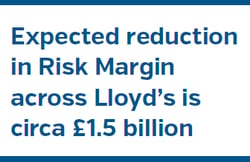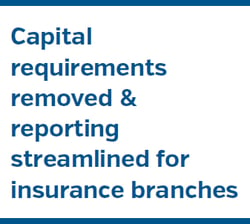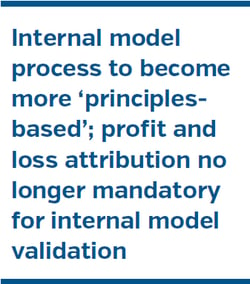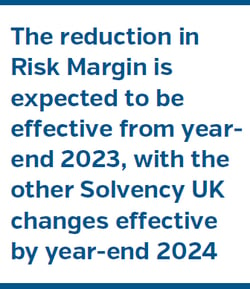Solvency UK
The Solvency II regulatory regime came into force across the European Union ("EU") on 1 January 2016. Following the UK’s exiting from the EU, the UK Government announced a review of the Solvency II framework and launched consultations in April 2022. It followed up with final proposals on 17 November 2022 and revealed draft legislation on 20 June 2023. The Prudential Regulation Authority (“PRA”) followed up with a consultation on technical details on 29 June 2023.
Edinburgh Reforms
On 9 December 2022, the UK Government introduced wide-ranging reforms across financial services to help the UK to become “the world’s most innovative and competitive global financial centre.”
Both sets of reforms include substantive policies which focus on encouraging competition, attracting capital, and facilitating long-term investments in the UK, and collectively will have a meaningful impact to London Market insurers. Like all things Brexit, there is an inherently political element about reducing “EU-derived burdens” in a post-Brexit world. The opposition Labour party has expressed support for these objectives, even though there is some disagreement on certain measures tabled by the government.
Solvency UK
The headline-grabbing measures impacting the insurance sector primarily apply to life insurers, in particular those with a sizable annuity business. For example, the reduction in the risk margin (see below for details) and re-calibration of rules governing the matching adjustment1 will both have a material impact on the balance sheets of life insurance companies. The former will reduce the sensitivity to interest rate movements, while the latter is likely to profoundly change the investment strategy relating to assets backing annuity liabilities.
London Market insurers will be impacted by measures in the following areas:
- Reduction in Risk Margin: The risk margin, under Solvency II, aims to approximate how much another insurer would charge for taking on certain insurance liabilities. It is combined with the best estimate liabilities to represent a “transfer value” of the liabilities (or “technical provisions” in Solvency II terms). As at 31 December 2022, Lloyd’s on aggregate reported £53.7bn in net technical provisions, including £4.4bn risk margin (increasing from £49.3bn and £4.1bn, respectively, as of 31
 December 2021).
December 2021).
The UK Government’s proposal is to reduce the “cost of capital” used in the risk margin calculation from 6% to 4%, which translates into a reduction of risk margin by one third. For Lloyd’s as a whole, this amounts to a small positive impact, i.e., a saving of c. £1.5bn as at 31 December 2022.
The positive impact is larger for life firms (estimated to be around 65% reduction), as they are allowed to “taper” the capital requirements for future periods. - Branch regulation:
Removal of capital requirements for insurance branches
The government has decided to remove capital requirements for insurance branches where the foreign parent groups are “appropriately capitalised.” It does not believe that this measure will put UK-headquartered firms in a disadvantageous position and emphasises that (apart from waiving capital requirements) all relevant UK regulatory requirements still apply to these branches.  This measure has been supported by the London Market Group, although the latter went further in advocating that the PRA could rely more on the supervision performed by the regulators of the parent entities.
This measure has been supported by the London Market Group, although the latter went further in advocating that the PRA could rely more on the supervision performed by the regulators of the parent entities.
The PRA consultation confirms that branches are no longer required to calculate or report capital requirements (including both the solvency capital requirement and minimum capital requirement) or risk margin, nor are they required to hold assets to cover them.
Recognising the added risk around policyholder protection from removing these requirements, the PRA notes that these branches “would already be subject to broadly equivalent home state” supervision. In addition, it reiterates an “indicative £500 million threshold” in insurance liabilities for the branch to be authorised as a subsidiary.
Streamlined reporting
Certain reporting templates are to be revised to reflect the above changes. To help streamline reporting, the PRA no longer expects branches to report detailed asset-side templates, as it considers the branch balance sheet to be sufficient.
The PRA is introducing a new annual template to collect the capital and solvency position of the branch legal entity, on both financial year and 3-year forecast basis. It also extends some of the National Specific Templates to cover branches.

The PRA estimates that the median annual savings for the changes in reporting is around £30,000, with one-off implementation costs ranging very widely, from £17,000 to £690,000 per branch.
- Internal model: The PRA is proposing to reduce the “level of prescription” and to make the internal model process (both new internal models and making changes to the existing internal model) more “principles-based.” The intention is to reduce the operational burdens for both the PRA and insurers, without negatively impacting the quality of internal models.
There are specific changes in areas, such as documentation and management actions. Arguably the most notable change is to the validation aspect: replacing the “profit and loss attribution” analysis with an “analysis of change” exercise. Lloyd’s already considers analysis of change as a key part of internal model validation, and it additionally requires both retrospective and prospective profit and loss attribution. It is currently unclear how Lloyd’s is going to evolve its requirements going forward.
Lloyd’s already considers analysis of change as a key part of internal model validation, and it additionally requires both retrospective and prospective profit and loss attribution. It is currently unclear how Lloyd’s is going to evolve its requirements going forward.
The Edinburgh Reforms
While most items from the ambitious Edinburgh Reforms would have an indirect impact on London Market insurers, we note a handful that can potentially impact them directly. These measures are generally expected to take longer to come into effect than the Solvency UK ones.
The Government has committed to short timelines and it remains to be seen how quickly the new measures could be consulted, finalised, and implemented. With the next general election expected in late 2024, it’s conceivable that there will be a change of government, which may backtrack on some of these reforms and make further changes on others.
- New secondary objective for the PRA and FCA: The government is planning to impose a new secondary objective to the regulators “to facilitate … the international competitiveness of the UK economy (including in particular the financial services sector) and its growth in the medium to long term.”
While the stance is welcome, it remains to be seen how the PRA and Financial Conduct Authority (“FCA”) position the new objective relative to their primary objectives and whether concrete policies will materialise to benefit London Market insurers. - Reforming the securitisation regulation: Historically, the unfriendly stance of Solvency II regulation towards investing in securitisation has meant that many London Market insurers shunned much of the asset class. In many cases, the investing is limited to agency mortgage-backed securities.
The FCA and PRA are going to clarify, under UK’s new securitisation regulation framework, the due diligence requirements for insurers to invest in securitisations, especially in non-UK securitisations. This is likely to provide clearer compliance parameters for London Market insurers and their asset managers to invest in securitisations in the US market. - Green Finance Strategy: The government’s 2023 strategy considers the insurance industry as an important contributor to both funding energy transition and providing technical expertise in dealing with the physical impact of climate risk. This may result in additional regulatory or tax incentives for insurers in the future.
- Bringing Environmental, Social, and Governance (“ESG”) ratings providers into the regulatory perimeter: The government is consulting on regulating ESG rating providers to make the following likely improvements: transparency of methodologies, governance, and processes. Given London Market insurers are increasingly tracking their portfolios’ ESG ratings, these improvements are likely to be beneficial to them.
- Reforming the Senior Managers & Certification Regime: The regulators and the Government are both reviewing the existing regime, which was implemented in 2018 for insurers and governs the conduct and accountability of senior management roles. To the extent that the reviews result in a more focused scope, including fewer requirements for smaller firms, this may alleviate the compliance burden for London Market insurers.
Key Takeaways
- Solvency UK will likely benefit London Market insurers through a reduction in Risk Margin and positive changes in branch regulation and the internal model process
- The Edinburgh Reforms will directly and indirectly impact London Market insurers, with headlines known, but the specifics and timing uncertain at this stage
- Both sets of reforms are designed to help the UK become more competitive internationally, though the PRA, the FCA and Lloyd’s will have material influences on the implications for London Market insurers
- Access to securitisation investments may become more straightforward, with the regulators expected to provide clearer compliance parameters
Reference
1 Matching adjustment is a spread that is included in the discount curve of certain qualifying liability cashflows. The calculation is portfolio-specific and it serves to reduce both the technical provisions and the Solvency Capital Requirement (“SCR”).
Bibliography
- HM Treasury - Review of Solvency II: Consultation
- Lloyd’s annual report 2022
- PRA Consultation paper 12/23 - Review of Solvency II: Adapting to the UK insurance market
- Lloyd’s Internal Model Validation Guidance January 2023
- London Market Group evidence submission - European Affairs Committee: UK-EU relationship in financial services
- Bank of England - DP1/23: Review of the Senior Managers and Certification Regime (SM&CR)
- Mobilising Green Investment - 2023 Green Finance Strategy









